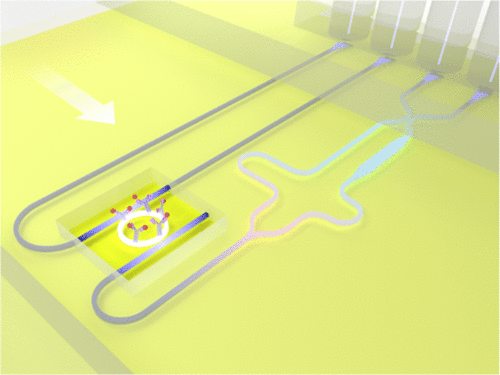Our official English website, www.x-mol.net, welcomes your
feedback! (Note: you will need to create a separate account there.)
Biotoxoid Photonic Sensors with Temperature Insensitivity Using a Cascade of Ring Resonator and Mach-Zehnder Interferometer.
ACS Sensors ( IF 8.2 ) Pub Date : 2020-07-15 , DOI: 10.1021/acssensors.0c00622 Zhenyu Li 1, 2 , Jun Zou 2 , Huihui Zhu 2 , Binh Thi Thanh Nguyen 2 , Yuzhi Shi 2 , Patricia Yang Liu 2 , Ryan C Bailey 3 , Jin Zhou 2 , Hong Wang 2 , Zhenchuan Yang 1 , Yufeng Jin 1 , Peng Huat Yap 4 , Hong Cai 5 , Yilong Hao 1 , Ai Qun Liu 2
ACS Sensors ( IF 8.2 ) Pub Date : 2020-07-15 , DOI: 10.1021/acssensors.0c00622 Zhenyu Li 1, 2 , Jun Zou 2 , Huihui Zhu 2 , Binh Thi Thanh Nguyen 2 , Yuzhi Shi 2 , Patricia Yang Liu 2 , Ryan C Bailey 3 , Jin Zhou 2 , Hong Wang 2 , Zhenchuan Yang 1 , Yufeng Jin 1 , Peng Huat Yap 4 , Hong Cai 5 , Yilong Hao 1 , Ai Qun Liu 2
Affiliation

|
The great advances in silicon photonic-sensing technology have made it an attractive platform for wide sensing applications. However, most silicon photonic-sensing platforms suffer from high susceptibility to the temperature fluctuation of an operating environment. Additional complex and costly chemical signal-enhancement strategies are usually required to improve the signal-to-noise ratio (SNR). Here, a biotoxoid photonic sensor that is resistant to temperature fluctuation has been demonstrated. This novel sensor consists of a ring resonator coupled to a Mach–Zehnder interferometer (MZI) readout unit. Instead of using costly wavelength interrogation, our photonic sensor directly measures the light intensity ratio between the two output ports of MZI. The temperature dependence (TD)-controlling section of the MZI is used to eliminate the adverse effects of ambient temperature fluctuation. The simulation and experimental results show a linear relationship between the interrogation function and the concentration of an analyte under operation conditions. The thermal drift of the proposed sensor is just 0.18%, which is a reduction of 567-fold for chemical sensing and 28-fold for immuno-biosensing compared to the conventional single-ring resonator. The SNR increases from 6.85 to 19.88 dB within a 2 °C temperature variation. The high SNR optical sensor promises great potential for amplification-free detection of nucleic acids and other biomarkers.
中文翻译:

使用级联的环形谐振器和Mach-Zehnder干涉仪,对温度不敏感的生物毒素光子传感器。
硅光子传感技术的巨大进步使其成为广泛传感应用的有吸引力的平台。但是,大多数硅光子传感平台都容易受到工作环境温度波动的影响。通常需要其他复杂且昂贵的化学信号增强策略来改善信噪比(SNR)。在此,已经证明了能够抵抗温度波动的生物毒素光子传感器。这种新颖的传感器包括一个耦合到Mach-Zehnder干涉仪(MZI)读出单元的环形谐振器。我们的光子传感器可以直接测量MZI两个输出端口之间的光强比,而无需使用昂贵的波长查询。MZI的温度相关性(TD)控制部分用于消除环境温度波动的不利影响。仿真和实验结果表明,在操作条件下,询问功能与分析物的浓度之间存在线性关系。所提出的传感器的热漂移仅为0.18%,与传统的单环谐振器相比,化学传感降低了567倍,免疫生物传感降低了28倍。在2°C的温度变化范围内,SNR从6.85 dB增加到19.88 dB。高SNR光学传感器有望在无扩增检测核酸和其他生物标记物方面具有巨大潜力。仿真和实验结果表明,在操作条件下,询问功能与分析物的浓度之间存在线性关系。所提出的传感器的热漂移仅为0.18%,与传统的单环谐振器相比,化学传感降低了567倍,免疫生物传感降低了28倍。在2°C的温度变化范围内,SNR从6.85 dB增加到19.88 dB。高SNR光学传感器有望在无扩增检测核酸和其他生物标记物方面具有巨大潜力。仿真和实验结果表明,在运行条件下,询问功能与分析物的浓度之间存在线性关系。所提出的传感器的热漂移仅为0.18%,与传统的单环谐振器相比,化学传感降低了567倍,免疫生物传感降低了28倍。在2°C的温度变化范围内,SNR从6.85 dB增加到19.88 dB。高SNR光学传感器有望在无扩增检测核酸和其他生物标记物方面具有巨大潜力。在2°C温度变化范围内为88 dB。高SNR光学传感器有望在无扩增检测核酸和其他生物标记物方面具有巨大潜力。在2°C温度变化范围内为88 dB。高SNR光学传感器有望在无扩增检测核酸和其他生物标记物方面具有巨大潜力。
更新日期:2020-08-28
中文翻译:

使用级联的环形谐振器和Mach-Zehnder干涉仪,对温度不敏感的生物毒素光子传感器。
硅光子传感技术的巨大进步使其成为广泛传感应用的有吸引力的平台。但是,大多数硅光子传感平台都容易受到工作环境温度波动的影响。通常需要其他复杂且昂贵的化学信号增强策略来改善信噪比(SNR)。在此,已经证明了能够抵抗温度波动的生物毒素光子传感器。这种新颖的传感器包括一个耦合到Mach-Zehnder干涉仪(MZI)读出单元的环形谐振器。我们的光子传感器可以直接测量MZI两个输出端口之间的光强比,而无需使用昂贵的波长查询。MZI的温度相关性(TD)控制部分用于消除环境温度波动的不利影响。仿真和实验结果表明,在操作条件下,询问功能与分析物的浓度之间存在线性关系。所提出的传感器的热漂移仅为0.18%,与传统的单环谐振器相比,化学传感降低了567倍,免疫生物传感降低了28倍。在2°C的温度变化范围内,SNR从6.85 dB增加到19.88 dB。高SNR光学传感器有望在无扩增检测核酸和其他生物标记物方面具有巨大潜力。仿真和实验结果表明,在操作条件下,询问功能与分析物的浓度之间存在线性关系。所提出的传感器的热漂移仅为0.18%,与传统的单环谐振器相比,化学传感降低了567倍,免疫生物传感降低了28倍。在2°C的温度变化范围内,SNR从6.85 dB增加到19.88 dB。高SNR光学传感器有望在无扩增检测核酸和其他生物标记物方面具有巨大潜力。仿真和实验结果表明,在运行条件下,询问功能与分析物的浓度之间存在线性关系。所提出的传感器的热漂移仅为0.18%,与传统的单环谐振器相比,化学传感降低了567倍,免疫生物传感降低了28倍。在2°C的温度变化范围内,SNR从6.85 dB增加到19.88 dB。高SNR光学传感器有望在无扩增检测核酸和其他生物标记物方面具有巨大潜力。在2°C温度变化范围内为88 dB。高SNR光学传感器有望在无扩增检测核酸和其他生物标记物方面具有巨大潜力。在2°C温度变化范围内为88 dB。高SNR光学传感器有望在无扩增检测核酸和其他生物标记物方面具有巨大潜力。











































 京公网安备 11010802027423号
京公网安备 11010802027423号